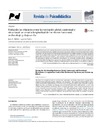Please use this identifier to cite or link to this item:
https://accedacris.ulpgc.es/jspui/handle/10553/41497
| Title: | Probando las relaciones entre la motivación global, contextual y situacional: un estudio longitudinal de los efectos horizontal, arriba-abajo y abajo-arriba | Other Titles: | Testing the relationships between global, contextual, and situational motivation: A longitudinal study of the horizontal, top-down, and bottom-up effects | Authors: | Núñez, Juan L. León, Jaime |
UNESCO Clasification: | 61 Psicología | Keywords: | Modelo jerárquico Teoría de la autodeterminación Efecto arriba-abajo Efecto abajo-arriba Estudio longitudinal, et al |
Issue Date: | 2018 | Journal: | Revista de Psicodidactica | Abstract: | El modelo jerárquico de la motivación intrínseca y extrínseca establece tres niveles de generalidad para analizar la motivación humana (global, contextual y situacional). El dinamismo de la motivación se explica de acuerdo a las relaciones entre estos niveles. El objetivo de este estudio es probar los efectos recíprocos, arriba-abajo y abajo-arriba, entre cada nivel motivacional y su adyacente, así como la estabilidad del nivel global (efecto horizontal). Se llevó a cabo un diseño longitudinal durante un periodo de cuatro meses. Los participantes fueron 142 estudiantes universitarios. Los resultados del path analisis, utilizando un método de estimación bayesiano, apoyaron las hipótesis planteadas. Finalmente, las implicaciones de los procesos dinámicos de influencia entre los niveles jerárquicos son discutidas en el contexto académico. The hierarchical model of intrinsic and extrinsic motivation establishes three levels of generality to analyze human motivation (global, contextual, and situational). The dynamism of motivation is explained by means of the relations between the three levels. The purpose of this study is to test the reciprocal effects, top-down and bottom-up, between one motivational level and the adjacent level, as well as the stability of the global level (horizontal effect). A longitudinal design with six measurement time points across a 4-month interval was used. Participants were 142 undergraduate students. Results from path analysis using a Bayesian estimation method provided support for our hypotheses. Finally, the implications of the dynamic processes of influence among the hierarchical levels in academic setting are discussed. |
URI: | https://accedacris.ulpgc.es/handle/10553/41497 | ISSN: | 1136-1034 | DOI: | 10.1016/j.psicod.2017.07.003 | Source: | Revista de Psicodidactica[ISSN 1136-1034],v. 23, p. 9-16 |
| Appears in Collections: | Artículos |
SCOPUSTM
Citations
12
checked on Jun 8, 2025
WEB OF SCIENCETM
Citations
8
checked on Jun 5, 2022
Page view(s)
502
checked on Sep 28, 2024
Download(s)
630
checked on Sep 28, 2024
Google ScholarTM
Check
Altmetric
Share
Export metadata
Items in accedaCRIS are protected by copyright, with all rights reserved, unless otherwise indicated.
